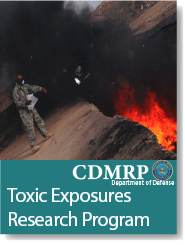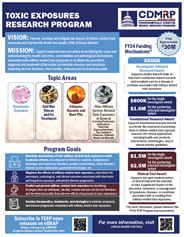Toxic Exposures
Vision – Prevent, minimize and mitigate the impact of military-related toxic exposures and improve the health and quality of life of those affected
There are a number of known and unknown potentially harmful substances that Service Members are exposed to during their military service. The CDMRP has previously received Congressional support for research aimed at providing healthcare solutions for some of the diseases/conditions linked to these exposures, including the Peer-Reviewed Gulf War Illness Research Program, the Peer Reviewed Medical Research Program Burn Pits and Metals Toxicology topic areas and the Peer-Reviewed Neurotoxin Exposure Treatment Parkinson's Research Program. Congress remains committed to helping Veterans affected by Parkinson's disease, Gulf War Illness, and others exposed to potentially toxic substances which result in multiple, diverse symptoms and health abnormalities. The Consolidated Appropriations Act, 2022 provides $30 million for a peer-reviewed, Toxic Exposures Research Program (TERP). The TERP is a new, broad program that will allow the research community to improve scientific understanding and pathobiology of toxic exposures, efficiently assess comorbidities, and speed the development of treatments, cures, and preventions. In line with the Congressional language, appropriated funds will be used to conduct research of clear scientific merit and direct relevance to neurotoxin exposure, Gulf War Illness and its treatment, airborne hazards and burn pits, as well as military service-related toxic exposures in general, including prophylactic medications, pesticides, organophosphates, toxic industrial chemicals, materials, metals, and minerals. The TERP will coordinate with similar activities in the U.S. Department of Veterans Affairs and encourage collaborations between researchers at military or Veteran institutions and non-military research institutions to leverage the knowledge, infrastructure, and access to military and Veteran populations.
The CDMRP held a virtual Stakeholders meeting on 15-16 June 2022, where individuals with relevant expertise and experience came together to identify knowledge gaps, targeted outcomes, and patient needs in neurotoxin exposure, Gulf War Illness and its treatment, exposures to airborne hazards and burn pits, and other military service-related toxic exposures in general, including prophylactic medications, pesticides, organophosphates, and toxic chemicals, materials, metals, and minerals, that can advance the state of the science and improve patient care. The FY22 TERP Stakeholders Book and FY22 TERP Stakeholders Meeting Summary, including the presentation slides, are provided below:
- FY22 TERP Stakeholders Book (1.7 MB)
- FY22 TERP Stakeholders Meeting Summary and Presentations (22.5 MB)
The full text for the appropriation supporting the inception of the Toxic Exposures Research Program can be found on pages 150-151 of the Joint Explanatory Statement as Division C, Part 2 of H.R. 2471, the Consolidated Appropriations Act, 2022. (Retrieved from: https://docs.house.gov/billsthisweek/20220307/BILLS-117RCP35-JES-DIVISION-C_Part2.pdf).
Resources for Investigators
![]()
Congressional Appropriations
- $60 million
FY22-23 - $30 million
FY24

Funding
Summary
- 58 Awards in FY22-23
- Recent Applications Recommended for Funding

Programmatic
Panels

Peer Review Participants
Last updated Wednesday, March 19, 2025

















